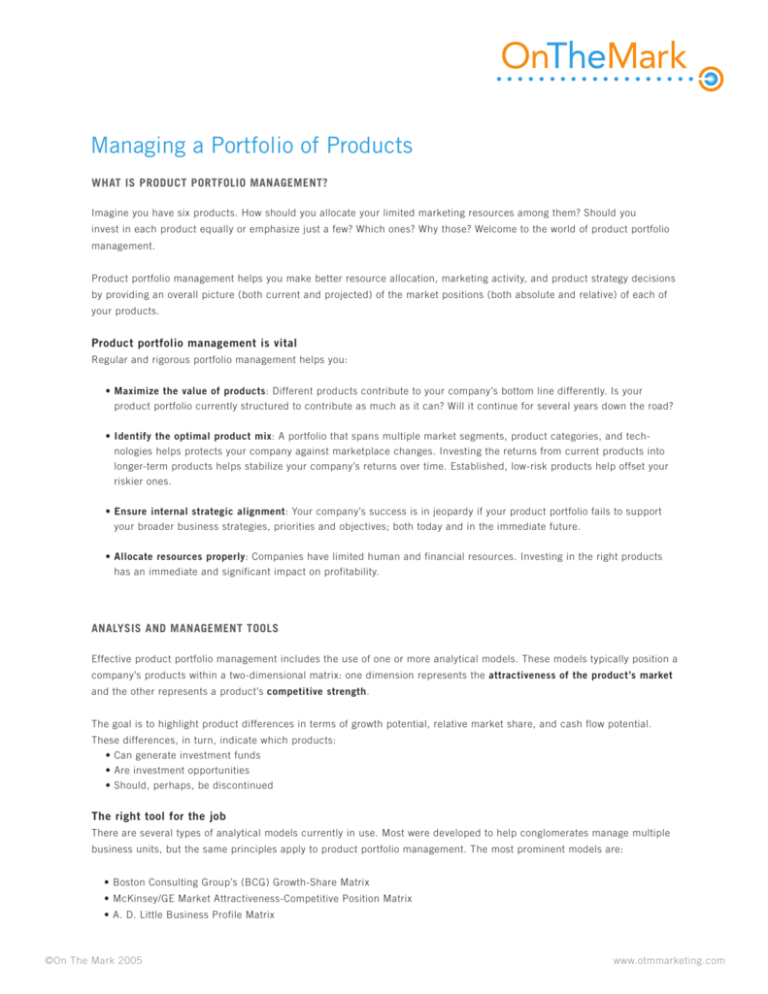Managing a Portfolio of Products
advertisement

Managing a Portfolio of Products What is product portfolio management? Imagine you have six products. How should you allocate your limited marketing resources among them? Should you invest in each product equally or emphasize just a few? Which ones? Why those? Welcome to the world of product portfolio management. Product portfolio management helps you make better resource allocation, marketing activity, and product strategy decisions by providing an overall picture (both current and projected) of the market positions (both absolute and relative) of each of your products. Product portfolio management is vital Regular and rigorous portfolio management helps you: • Maximize the value of products: Different products contribute to your company’s bottom line differently. Is your product portfolio currently structured to contribute as much as it can? Will it continue for several years down the road? • Identify the optimal product mix: A portfolio that spans multiple market segments, product categories, and technologies helps protects your company against marketplace changes. Investing the returns from current products into longer-term products helps stabilize your company’s returns over time. Established, low-risk products help offset your riskier ones. • Ensure internal strategic alignment: Your company’s success is in jeopardy if your product portfolio fails to support your broader business strategies, priorities and objectives; both today and in the immediate future. • Allocate resources properly: Companies have limited human and financial resources. Investing in the right products has an immediate and significant impact on profitability. Analysis and management tools Effective product portfolio management includes the use of one or more analytical models. These models typically position a company’s products within a two-dimensional matrix: one dimension represents the attractiveness of the product’s market and the other represents a product’s competitive strength. The goal is to highlight product differences in terms of growth potential, relative market share, and cash flow potential. These differences, in turn, indicate which products: • Can generate investment funds • Are investment opportunities • Should, perhaps, be discontinued The right tool for the job There are several types of analytical models currently in use. Most were developed to help conglomerates manage multiple business units, but the same principles apply to product portfolio management. The most prominent models are: • Boston Consulting Group’s (BCG) Growth-Share Matrix • McKinsey/GE Market Attractiveness-Competitive Position Matrix • A. D. Little Business Profile Matrix ©On The Mark 2005 www.otmmarketing.com Page 2 The remainder of this article will focus on the BCG Growth-Share Matrix, given its widespread acceptance, relative simplicity, and proven value. The Boston Consulting Group’s Growth-Share Matrix The BCG Growth-Share Matrix displays three elements of information for each product: 1. Product sales volume is indicated by the diameter of the product circle. The greater the volume, the larger the circle. 2. Market growth rate is indicated by the product circle’s position on the vertical axis. Market growth rate represents the attractiveness of the market segment in which the product is competing. Formula: Market growth rate = (market segment sales for the current year – market segment sales last year) / market segment sales last year 3. Relative market share is indicated by the product circle’s position on the horizontal axis. Relative market share represents the competitive strength of your product compared to the market leader’s product. Formula: Relative market share = your product’s sales this year / your leading competitor’s product’s sales this year Plot each of your products on the same matrix to create a visual representation of the status and performance of your entire product portfolio. Sample company—current year Below is a matrix with some sample data. Notice that the matrix breaks down into four sections: BCG Growth Share Matrix for Sample Company – Current Situation The quadrants BCG labels the quadrants of the matrix: Star, Cash Cow, Question Mark, and Dog. Each quadrant is classified according to sales growth opportunities, market share, and cash flow: ©On The Mark 2005 www.otmmarketing.com Page 3 • Stars: Products in this quadrant are high-growth, high-share. They are extremely attractive because the industry is robust and the product holds a strong competitive position. Stars generate large amounts of cash, but also require heavy investment to grow and maintain; thus, net cash flow is usually modest. • Cash Cows: Products in this quadrant are slow-growth, high-share. They are a key source of cash and are typically core to the overall business. They have a strong competitive position but are in a mature market—one neither growing nor declining. These products generate more cash than they require, thus providing investment funds for other products. • Question Marks: Products in this quadrant are high-growth, low-share. Low market share often means low profits and weak cash flows because the market is growing faster than the product. New products are often question marks and may require substantial investment to increase market share. Products that have been in the market for some time and are still question marks are potential candidates for disinvestment. • Dogs: Products in this quadrant are low-growth, low-share. They neither generate nor require significant amounts of cash. Their profitability is low because of their low market share. Maintaining market share requires only modest cash investments. Typically, older products in older markets fall into this quadrant (and are almost always candidates for disinvestment). An exception would be a new product in a new market. These may be Dogs for awhile, and then move to Question Mark or Star. In summary, the characteristics of each quadrant are: Quadrant Profits (before investment) Required investment Net cash flow Star High High Modest Cash Cow High Low High Question Mark None or Negative Very high (or disinvest) Very negative or barely positive Dog Low or Negative Disinvest Positive (from disinvestment proceeds or savings) Interpreting a completed matrix Once you have incorporated each product into the matrix and understand the characteristics of each quadrant, you can start assessing current and future product portfolio strategies. BCG recommends the following strategies, depending on which quadrant your product falls: Quadrant Strategy Star Hold or invest Cash Cow Hold Question Mark Invest or disinvest Dog Hold or disinvest Sample company—THREE YEARS OUT Let’s apply the above strategies to the sample company. The revised matrix on the following page indicates strategy recommendations based on three-year financial projections and additional management estimates regarding market changes. The arrows indicated predicted movement of the product over time. ©On The Mark 2005 www.otmmarketing.com Page 4 BCG Growth Share Matrix for Sample Company – Three Years from Now Purple Star product: The market is likely to begin maturing (i.e. experience a slower growth rate); however, this Star product is expected to continue to increase market share at the expense of its competitors. So the strategy is to Hold— maintain current investment levels and continue to gain market share. The hope is that this Star will become a Cash Cow. Red Cash Cow product: This mature market is not expected to grow or decline much in the coming years. The strategy for this Cash Cow is to Hold and use the cash flow to invest in other worthy products. Blue Question Mark product: This relatively new product is expected to perform very well in a rapidly expanding market. The strategy is to Invest and achieve even more market share during this growth period. Although this may mean negative cash flow for the product, the portfolio’s cash flow should remain positive due to the robust Cash Cow product. Green Question Mark product: This older product has been stagnant for some time, even after substantial cash investments. And market growth is expected to slow in the future. Disinvestment is the right strategy—but at what speed? Industry analysts predict that several companies will discontinue their products very soon. If true, this leaves an opportunity for a soft landing strategy (i.e. disinvest more slowly than competitors to gain some market share and improve margins slightly during the disinvestment process). Black Dog product: This product has been out for a couple of years, but the market never really took off; the negative cash flows have been a burden to the overall portfolio. The performance of both the market and product are deemed unlikely to improve—Disinvestment is the best strategy. Yellow Dog product: This is a new product in a new market, both of which show quite a bit of promise. This scenario is an exception to BCG suggestions—Investment is an appropriate strategy here. Final words of advice • Strategy before allocation: Once you have identified the combination of product strategies that maximize the value of your portfolio, you can then more clearly identify which resources (both financial and human) should be invested in each product. • Matrix analysis isn’t enough: Matrix analysis is an invaluable starting point, but final product portfolio strategy and ©On The Mark 2005 www.otmmarketing.com Page 5 management decisions must incorporate other market insights, including: customer trends, competitive strengths and weaknesses, and best-guess market predictions. • Estimates are much better than nothing: Getting the information needed to conduct product portfolio management is not always easy; but the process is vitally important. Make educated assumptions to close information gaps, but track those assumptions over time and adjust accordingly. ©On The Mark 2005 www.otmmarketing.com









